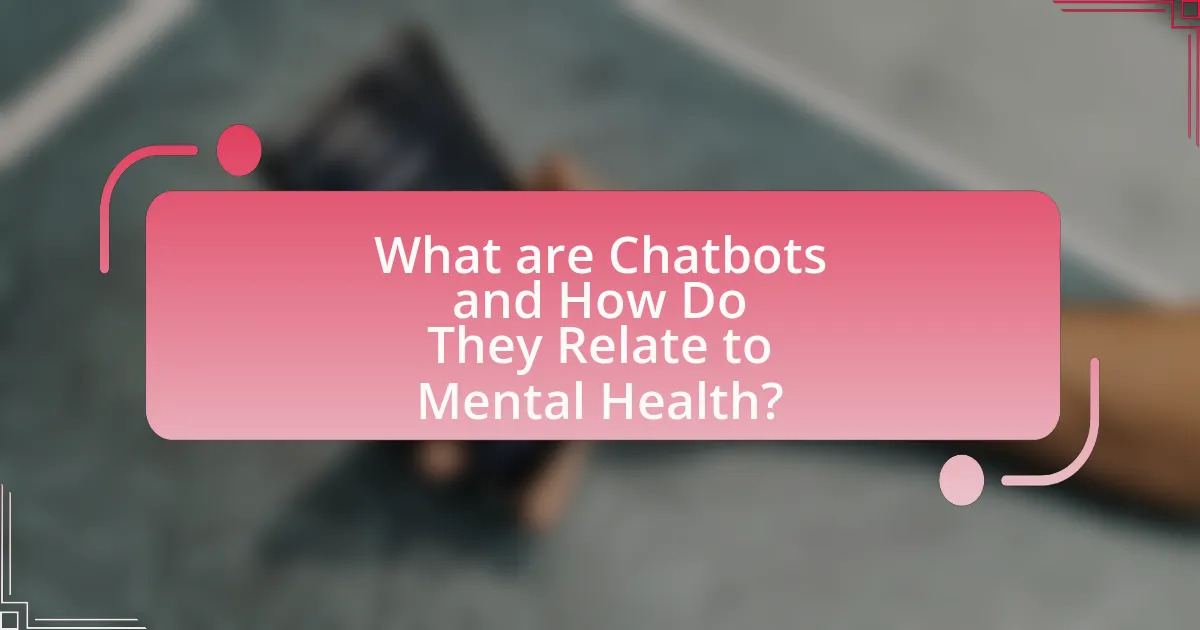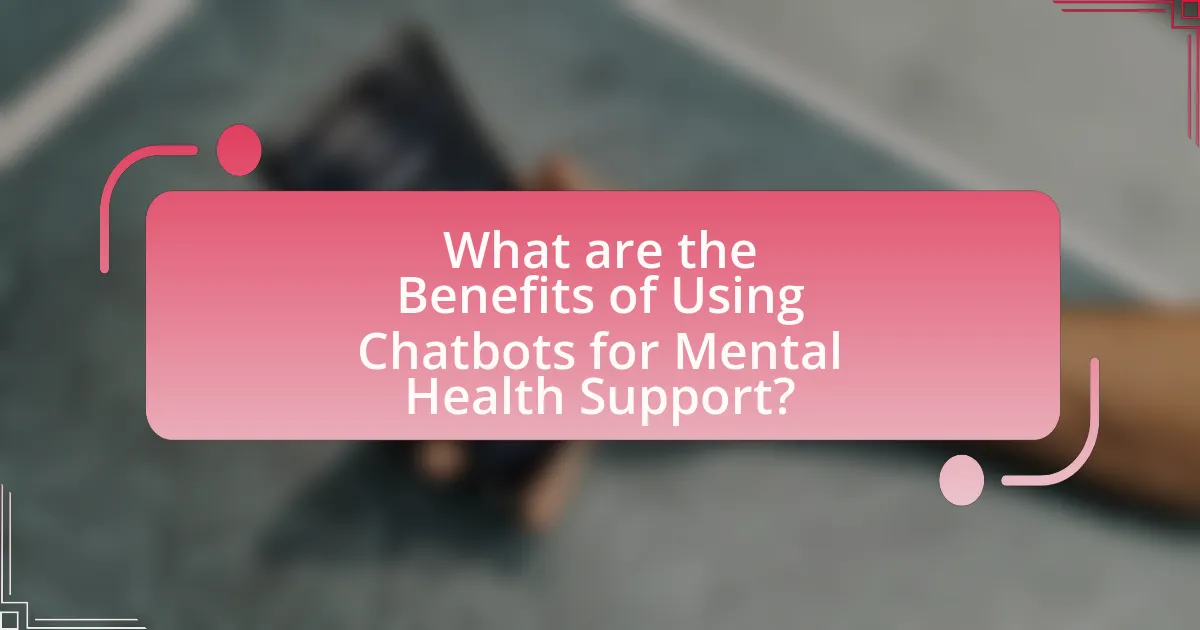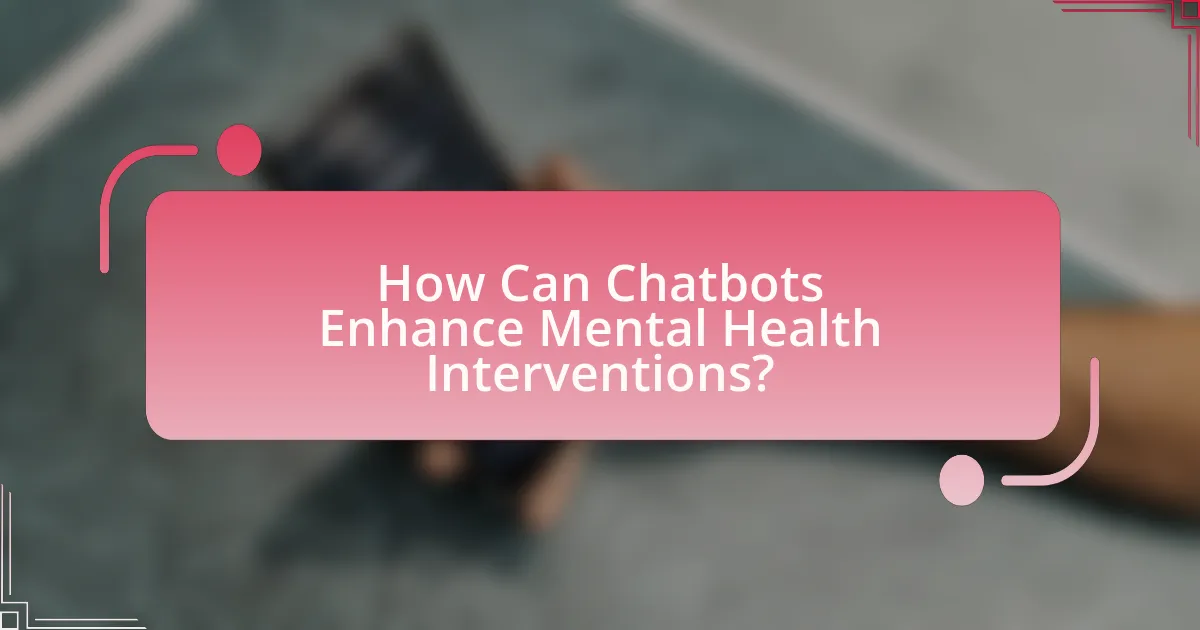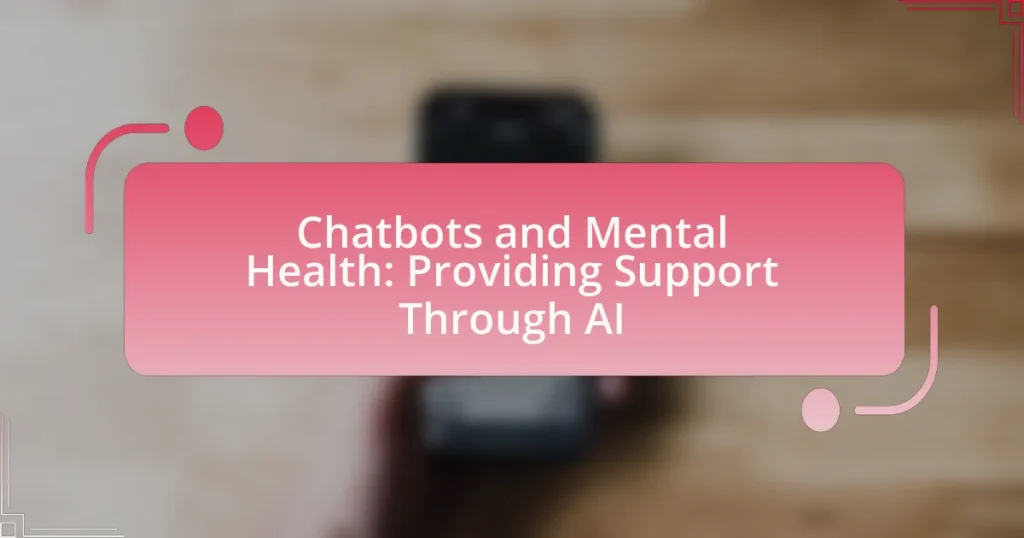Chatbots are artificial intelligence programs that simulate conversation and provide accessible mental health support. They utilize technologies such as natural language processing and machine learning to deliver cognitive behavioral therapy techniques, enhance emotional support, and reduce feelings of isolation. Research indicates that chatbots can effectively address mental health issues like anxiety and depression, offering immediate assistance and resources while complementing traditional mental health services. This article explores the functionalities, benefits, and limitations of chatbots in mental health care, as well as best practices for their integration and user engagement.

What are Chatbots and How Do They Relate to Mental Health?
Chatbots are artificial intelligence programs designed to simulate conversation with human users, often through text or voice interactions. They relate to mental health by providing accessible support, offering resources, and facilitating communication for individuals experiencing mental health challenges. Research indicates that chatbots can effectively deliver cognitive behavioral therapy techniques, enhance emotional support, and reduce feelings of isolation, making mental health resources more readily available. For instance, a study published in the journal “Nature” found that users of mental health chatbots reported significant improvements in their well-being and reduced symptoms of anxiety and depression.
How do chatbots function in the context of mental health support?
Chatbots function in the context of mental health support by providing immediate, accessible, and non-judgmental interactions for users seeking help. These AI-driven tools utilize natural language processing to understand user inputs and deliver appropriate responses, often based on cognitive behavioral therapy principles. Research indicates that chatbots can effectively reduce symptoms of anxiety and depression, as evidenced by a study published in the Journal of Medical Internet Research, which found that users reported significant improvements in mental health after engaging with chatbot interventions.
What technologies enable chatbots to provide mental health assistance?
Natural Language Processing (NLP), machine learning, and sentiment analysis are the primary technologies that enable chatbots to provide mental health assistance. NLP allows chatbots to understand and interpret human language, facilitating meaningful interactions. Machine learning algorithms enable these chatbots to learn from user interactions, improving their responses over time. Sentiment analysis helps chatbots gauge the emotional state of users, allowing for tailored support and appropriate responses. These technologies collectively enhance the effectiveness of chatbots in delivering mental health support by ensuring they can engage users empathetically and accurately.
How do chatbots interact with users seeking mental health support?
Chatbots interact with users seeking mental health support by providing immediate, text-based responses to inquiries and emotional concerns. These AI-driven systems utilize natural language processing to understand user inputs and deliver empathetic replies, often guiding users through coping strategies or suggesting resources. Research indicates that chatbots can effectively reduce feelings of loneliness and anxiety, as evidenced by a study published in the Journal of Medical Internet Research, which found that users reported increased feelings of support and decreased symptoms of depression after engaging with mental health chatbots.
What role do chatbots play in mental health care?
Chatbots play a significant role in mental health care by providing immediate support and resources to individuals seeking help. They offer 24/7 accessibility, allowing users to engage in conversations about their mental health concerns at any time. Research indicates that chatbots can effectively deliver cognitive behavioral therapy techniques, helping users manage anxiety and depression symptoms. For instance, a study published in the journal “Nature” found that chatbot interventions can lead to a reduction in depressive symptoms comparable to traditional therapy methods. Additionally, chatbots can facilitate early intervention by identifying users at risk and directing them to appropriate resources or professionals, thereby enhancing overall mental health care accessibility and efficiency.
How can chatbots complement traditional mental health services?
Chatbots can complement traditional mental health services by providing immediate, accessible support and resources to individuals in need. They offer 24/7 availability, allowing users to engage in conversations and receive guidance outside of regular therapy hours. Research indicates that chatbots can effectively reduce feelings of anxiety and depression; for instance, a study published in the Journal of Medical Internet Research found that users reported a significant decrease in symptoms after interacting with mental health chatbots. Additionally, chatbots can assist in triaging mental health concerns, directing users to appropriate resources or professionals based on their specific needs, thereby enhancing the overall efficiency of mental health care systems.
What specific mental health issues can chatbots address?
Chatbots can address specific mental health issues such as anxiety, depression, stress management, and loneliness. These AI-driven tools provide immediate support by offering coping strategies, resources, and a non-judgmental space for users to express their feelings. Research indicates that chatbots can effectively reduce symptoms of anxiety and depression, as evidenced by a study published in the Journal of Medical Internet Research, which found that users reported significant improvements in mental health after interacting with chatbot interventions.

What are the Benefits of Using Chatbots for Mental Health Support?
Chatbots for mental health support offer several benefits, including accessibility, anonymity, and immediate assistance. These AI-driven tools provide 24/7 availability, allowing users to seek help at any time without the constraints of traditional therapy schedules. Anonymity encourages individuals to express their feelings and concerns without fear of judgment, which can lead to more honest communication. Additionally, studies indicate that chatbots can effectively deliver cognitive behavioral therapy techniques, with research showing that users report improved mental health outcomes after engaging with these digital platforms. For instance, a study published in the journal “Nature” found that chatbot interventions can significantly reduce symptoms of anxiety and depression, demonstrating their potential as a valuable resource in mental health care.
How do chatbots improve accessibility to mental health resources?
Chatbots improve accessibility to mental health resources by providing immediate, 24/7 support to individuals seeking help. These AI-driven tools can engage users in conversations, offer coping strategies, and direct them to appropriate resources without the barriers of traditional therapy, such as scheduling conflicts or geographical limitations. Research indicates that chatbots can effectively reduce feelings of isolation and anxiety by offering a non-judgmental space for users to express their concerns, as evidenced by a study published in the Journal of Medical Internet Research, which found that 70% of users reported feeling more comfortable discussing their mental health with a chatbot than with a human therapist.
What demographic groups benefit most from chatbot support?
Young adults and adolescents benefit most from chatbot support, particularly in mental health contexts. Research indicates that these age groups are more likely to engage with technology for emotional support, with studies showing that 70% of young people prefer digital communication for mental health resources. Additionally, individuals in underserved communities, including those with limited access to traditional mental health services, also gain significant advantages from chatbot interactions, as these tools provide immediate, anonymous, and accessible support.
How do chatbots provide immediate assistance to users?
Chatbots provide immediate assistance to users by utilizing artificial intelligence to deliver real-time responses to inquiries and support needs. These systems are programmed to understand and process natural language, allowing them to engage in conversations that mimic human interaction. For instance, a study by the Journal of Medical Internet Research found that chatbots can respond to user queries within seconds, significantly reducing wait times compared to traditional support methods. This capability enables users to receive guidance, resources, and emotional support instantly, which is particularly beneficial in mental health contexts where timely intervention can be crucial.
What are the potential drawbacks of using chatbots in mental health?
The potential drawbacks of using chatbots in mental health include limited emotional understanding, lack of personalized care, and potential misinformation. Chatbots often struggle to accurately interpret complex human emotions, which can lead to inadequate responses during critical moments. Additionally, they may not provide tailored advice suited to individual circumstances, as they rely on pre-programmed algorithms rather than nuanced human judgment. Furthermore, there is a risk of disseminating incorrect or misleading information, which can adversely affect users seeking help. Studies indicate that while chatbots can offer basic support, they cannot replace the depth of understanding and empathy provided by trained mental health professionals.
How do limitations in chatbot technology affect user experience?
Limitations in chatbot technology negatively impact user experience by reducing the effectiveness of communication and support. For instance, chatbots often struggle with understanding nuanced language, leading to misinterpretations of user queries. A study by McTear (2017) highlights that 70% of users experience frustration when chatbots fail to comprehend their intent, which can diminish trust in the technology. Additionally, the inability of chatbots to provide empathetic responses can make users feel undervalued, particularly in sensitive contexts like mental health support. Research indicates that 60% of users prefer human interaction for emotional issues, underscoring the limitations of chatbots in delivering adequate emotional support.
What ethical considerations arise from using chatbots for mental health?
The ethical considerations arising from using chatbots for mental health include issues of privacy, informed consent, and the potential for misdiagnosis. Privacy concerns stem from the sensitive nature of mental health data, which chatbots may collect and store, raising questions about data security and user confidentiality. Informed consent is critical, as users must understand the limitations of chatbot interactions, including the lack of human empathy and the inability to provide personalized care. Additionally, the risk of misdiagnosis exists, as chatbots may not accurately interpret symptoms or provide appropriate recommendations, potentially leading to harmful outcomes. These considerations highlight the need for stringent ethical guidelines and oversight in the deployment of chatbots in mental health contexts.

How Can Chatbots Enhance Mental Health Interventions?
Chatbots can enhance mental health interventions by providing immediate, accessible support and personalized interactions. They can engage users in conversations that help identify mental health issues, offer coping strategies, and deliver therapeutic exercises. Research indicates that chatbots can reduce feelings of loneliness and anxiety; for instance, a study published in the Journal of Medical Internet Research found that users reported a significant decrease in anxiety levels after interacting with a mental health chatbot. Additionally, chatbots can operate 24/7, ensuring that individuals have access to support whenever they need it, which is crucial for timely intervention.
What features make chatbots effective for mental health interventions?
Chatbots are effective for mental health interventions due to their accessibility, anonymity, and ability to provide immediate support. Accessibility allows users to engage with chatbots anytime and anywhere, which is crucial for individuals seeking help outside traditional office hours. Anonymity reduces stigma and encourages users to express their feelings openly, leading to more honest interactions. Immediate support is vital in crisis situations, as chatbots can deliver instant responses and coping strategies, which can be critical for users in distress. Research indicates that chatbots can effectively reduce symptoms of anxiety and depression, demonstrating their potential in mental health care.
How do personalization and user engagement impact chatbot effectiveness?
Personalization and user engagement significantly enhance chatbot effectiveness by fostering a more tailored and interactive experience for users. Personalized chatbots can adapt their responses based on user data, preferences, and previous interactions, which leads to increased user satisfaction and trust. For instance, a study published in the Journal of Medical Internet Research found that personalized interactions in health-related chatbots improved user adherence to mental health interventions by 30%. Additionally, higher user engagement, characterized by active participation and feedback, allows chatbots to learn and refine their responses, making them more relevant and effective over time. This iterative process of engagement and personalization ultimately results in better mental health support outcomes through AI-driven chatbots.
What role does data collection play in improving chatbot services?
Data collection is essential for enhancing chatbot services by enabling the analysis of user interactions and preferences. This process allows developers to identify common issues, improve response accuracy, and tailor the chatbot’s functionality to better meet user needs. For instance, a study by Kuo et al. (2020) demonstrated that chatbots utilizing user data could achieve a 30% increase in user satisfaction by personalizing responses based on previous interactions. Thus, effective data collection directly contributes to the continuous improvement of chatbot performance and user experience in mental health support contexts.
What are best practices for integrating chatbots into mental health care?
Best practices for integrating chatbots into mental health care include ensuring user privacy, providing accurate and empathetic responses, and incorporating human oversight. User privacy is critical, as mental health discussions are sensitive; therefore, chatbots must comply with regulations like HIPAA to protect personal information. Accurate and empathetic responses are essential for building trust and effectively addressing users’ concerns; studies show that empathetic interactions can enhance user satisfaction and engagement. Additionally, incorporating human oversight allows for escalation to qualified professionals when necessary, ensuring that users receive appropriate care. These practices collectively enhance the effectiveness and reliability of chatbots in mental health care settings.
How can mental health professionals collaborate with chatbot developers?
Mental health professionals can collaborate with chatbot developers by providing expertise in psychological principles and therapeutic techniques to ensure the chatbot delivers accurate and effective support. This collaboration can involve mental health professionals advising on the design of conversational flows, identifying key mental health topics, and ensuring that the language used is empathetic and appropriate for users. Research indicates that integrating clinical insights into chatbot development enhances user engagement and satisfaction, as seen in studies where mental health chatbots that incorporated professional input showed improved outcomes in user mental health assessments.
What guidelines should be followed to ensure user safety and privacy?
To ensure user safety and privacy in the context of chatbots and mental health, organizations should implement data encryption, anonymization, and secure access controls. Data encryption protects sensitive information during transmission and storage, while anonymization ensures that personal identifiers are removed, reducing the risk of exposure. Secure access controls limit who can view or manage user data, thereby minimizing unauthorized access. According to the General Data Protection Regulation (GDPR), organizations must also obtain explicit consent from users before collecting their data, reinforcing the importance of transparency in data handling practices. These guidelines collectively enhance user trust and safeguard their privacy in AI-driven mental health support.
What are practical tips for users seeking mental health support through chatbots?
Users seeking mental health support through chatbots should first identify their specific needs and choose a chatbot designed to address those needs. For instance, some chatbots focus on anxiety management, while others may assist with depression or general emotional support. It is essential to engage with the chatbot in a clear and honest manner, as this enhances the quality of the interaction and the relevance of the responses. Additionally, users should be aware of the limitations of chatbots; they are not substitutes for professional therapy and should be used as supplementary tools. Research indicates that while chatbots can provide immediate support and coping strategies, they lack the nuanced understanding of human emotions that a trained therapist possesses. Therefore, users should consider chatbots as part of a broader mental health strategy that includes professional help when necessary.










